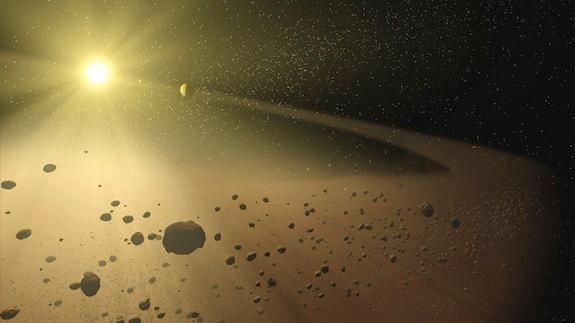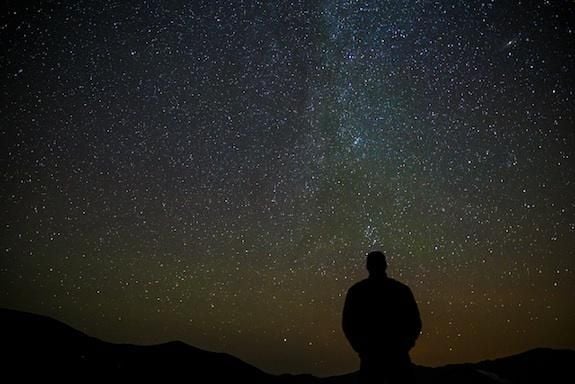Look Up! Venus, Jupiter and Mercury Conjoin this Evening
Kimberly Arcand and Megan Watzke, authors of “Your Ticket to the Universe,” point out a few wonders of the cosmos
/https://tf-cmsv2-smithsonianmag-media.s3.amazonaws.com/filer/201305280250419781588343758.jpg)
Gaze at the stars this evening and you will see a rare phenomenon: three planets, all glowing so close to each other that it looks like they might bump. The trio—Venus, Jupiter and Mercury—actually are millions of miles apart, but on this special occasion their orbits are aligned with ours such that they appear side by side.
The Milky Way is home to an estimated 200 billion to 400 billion stars, and as many as 17 billion planets. Amazing things are happening around the cosmos every minute, but it is a treat when we can catch an unusual celestial event just by looking up, without even a telescope.
Tonight and in the coming months, a few of these events will be visible to the naked eye from any backyard in the United States so long as the sky is free of clouds. Be sure to mark your calendars—the events are fleeting, and occur at most once a year.
To make sense of these celestial happenings, we enlisted the help of Kimberly Arcand and Megan Watzke, authors of Your Ticket to the Universe: A Guide to Exploring the Cosmos, recently published by Smithsonian Books. Arcand and Watzke both work as communications officers for NASA’s Chandra X-ray Observatory, which means they have extensive experience dealing with the cosmos and capturing arresting astronomical images. The two have collaborated before on From Earth to the Universe and From Earth to the Solar System, two projects that bring the universe’s wonders down to earth in breathtaking photographs. Their new book features 240 full-color images from telescopes, observatories and in-space cameras, including the Hubble and Spitzer Space Telescopes and NASA’s Curiosity rover.
“You don’t need a medical degree to know when you’re sick or a doctorate in literature to appreciate a novel,” Arcand and Watzke write. “In the same spirit, even those of us who do not have advanced degrees in astronomy, astrophysics or space science can gain access to all the wonder and experience that the Universe has to offer.”
If this list whets your appetite for more exciting cosmological happenings, check out the book to learn far more amazing facts about the Universe, and peruse some of these lists of even more celestial events taking place this year.
Happy viewing!

Tuesday, May 28: Conjunction of Venus, Jupiter and Mercury
In celestial terms, “conjunctions” are when two or more objects appear really close together in the sky. On this rare night, Venus and Jupiter will come within 1 degree of each other, and Mercury, which has been close to the pair since Friday, will be within 5 degrees of them. According to NASA, the last time triple conjunction occurred in 2011, and another. won’t be seen until October 2015.
The three planets will be most visible 45 minutes to an hour after sunset. In the twilight, look west-northwest and low in the sky. Venus is the brightest of the three planets, and Jupiter will be close above it to the right.
Arcand and Watzke say:
Planets are always fun objects to try to find in the night sky. Because they are closer to us than the stars (other than the Sun, of course), they appear as tiny solid disks rather the just pinpricks of light. This means that the planets appear to be less affected by the blurring effects of our atmosphere, which is what causes the stars to “twinkle.” (But stars don’t actually twinkle. The movements of air and moisture in the Earth’s atmosphere makes the distant light look like it’s changing in ways that it is not.)
Venus and Jupiter are not actually any nearer each other than normal–they just appear to align from our vantage point on Earth. Venus is still closer to the Sun than the Earth, and Jupiter remains in its orbit as the fifth planet out at an average of about 500 million miles from the center of the Solar System.
Fun fact: Venus is often a great night sky viewing target and was long referred to as “the evening star” because of it’s clear and early appearance in the evening. So we’re often wishing on a planet and not a star if we wish up on the first bright light of the evening.

Saturday to Sunday, June 23 to 24: Supermoon
The biggest full moon of 2013! On Sunday at 7 a.m. GMT (that’s 3 a.m. in New York, midnight in Los Angeles), the moon will reach it’s closest point to earth of the year, a mere 221,824 miles away. That’s not quite close enough to touch, but it may look like it is.
Arcand and Watzke say:
As the Moon travels in its orbit around Earth, more or less of the Moon’s disk is illuminated by the Sun. When the Moon is behind the Earth with respect to the Sun, we can see its full face lit up by sunlight. This is what we know as the “full Moon,” and it occurs once every 27 days or so. Use the opportunity of a fully illuminated Moon—especially this big one—to get a really good look at our nearest neighbor in space. The pockmarks are the result of meteors that have struck the lunar surface. Because the Moon has essentially no atmosphere or weather like we do on Earth, these craters have been preserved in pristine condition instead of being erased like those on Earth largely have.
Fun fact: On the occasional times a full moon happens 13 times in a year, instead of 12, the last full moon is called a “Blue Moon”, which is where the phrase comes from.

July and August: Meteor Showers
Two major annual meteor showers, the Delta Aquarid and the Perseid, will be shooting across the night sky throughout most of July and August.
The Delta Aquarid Meteor Shower runs from July 12 to August 23, and peaks from July 27 to 28 with up to 20 meteors per hour. It comes from the debris of comets Marsden and Kracht. It is not highly visible in America, and best seen from the Southern Hemisphere and at low altitudes just north of the equator. Light from the moon, in its second quarter, will block most of the faint meteors from sight, too, but you should still be able to see at least some of the big ones if you’re on the lookout for them.
The Perseid Meteor Shower runs from July 17 to August 24, and peaks from August 11 to 12 with up to 60 meteors per hour. It is produced by comet Swift-Tuttle. Unlike the Delta Aquarid, it is highly visible in the Northern Hemisphere, and peaks during a first quarter moon, which means hardly any light will obstruct the show.
Arcand and Watzke say:
Meteor showers are great to plan summer evenings around. These showers happen when the Earth passes through a cloud of rocks from a comet that has been ripped apart by gravity. While many people want to use binoculars or telescopes in order to get the best views of events in the night sky, meteor showers are actually best viewed with just your eyes. That’s because binoculars or a telescope will limit your field of view. The game in watching meteor showers is to get the widest and darkest view of the night sky.
Fun fact: Despite their nickname of “shooting stars” in popular culture, these are not stars at all. Impress your friends and family by pointing out that these streaks of light are, in fact, pieces of rock and other debris whizzing through the Earth’s atmosphere.
/https://tf-cmsv2-smithsonianmag-media.s3.amazonaws.com/accounts/headshot/paul-bisceglio-240.jpg)
/https://tf-cmsv2-smithsonianmag-media.s3.amazonaws.com/accounts/headshot/paul-bisceglio-240.jpg)